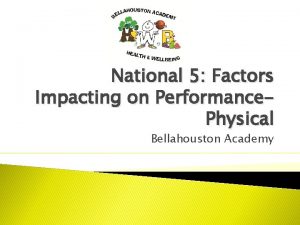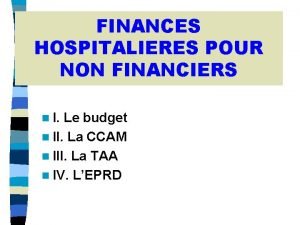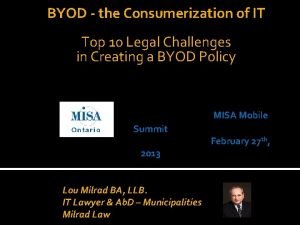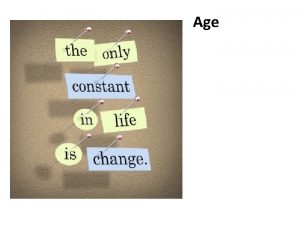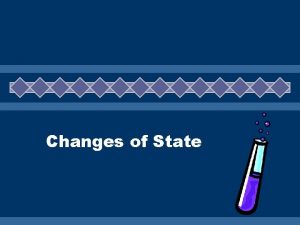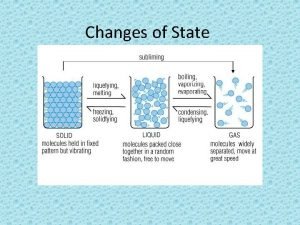Recent State Changes in Laws and Finances Impacting

















































- Slides: 49

Recent State Changes in Laws and Finances Impacting Children and Youth: What are they all about? CMHACY Thursday, May 18, 2017 Workshop A-5 Scripps

What we’re going to cover: • Continuum of Care Reform Implementation • “Out-of-County” Mental Health • Children’s Mental Health Crisis Continuum of Care • Full-Scope Medi-Cal for Undocumented Immigrant Children • Minors Who are Trafficked May No Longer be Arrested and Charged with Prostitution

Continuum of Care Reform Implementation

What is bigger than CCR? Continuum of Care Reform: “A comprehensive approach to improving the experience and outcomes of children and youth in foster care. ” A once in a generation opportunity to get foster care right. Still have plenty of time to screw it up.

CCR: What we hope for

Continuum of Care Reform • AB 403 (Stone; 2015) • AB 1997 (Stone; 2016) • AB 404 (Stone; introduced, 2017)

CCR creates 2 levels of care 1. Home-based family care • • • Kin care NREFM care County licensed foster family homes FFA certified foster homes Pre-adoptive families 2. Short-Term Residential Therapeutic Programs Goal: Home-based family care for all children and youth in foster care; permanent families for children exiting foster care.

To accomplish this… • Group homes, as placements, go away • Short Term Residential Therapeutic Programs, as interventions, are created

How will STRTPs be different from traditional group care? • “Group home” as place to live, gives way to “short-term residential therapeutic program” as an intervention or means to get somewhere else…back to family and community. • It’s the train, not the station.

To accomplish this… • Group homes, as placements, go away • Short Term Residential Therapeutic Programs, as interventions, are created • Foster families, pre-adoptive and kin care families with separate and duplicative licensing and certification processes, go away • Resource families are created using a single RFA approval process Needed individualized Social Services & Support and Behavioral Health Treatment and Therapies are available to all foster children and youth independent of where and with whom they live.

Core Services • STRTPs and FFAs are required to provide or provide for Core Services: – Specialty mental health services – Transition services – Education, physical, behavioral, mental health, extracurricular supports – Transition to adulthood services – Permanency support services – Indian Child Services

Core Services • STRTPs and FFAs are required to provide or provide for Core Services: Specialty mental health services Transition services ü Education, physical, behavioral, mental health, extracurricular supports Transition to adulthood services Permanency support services Indian Child Services

For this change to occur successfully • There have to be enough resource families who are willing and able to care for youth and children with deep and enduring needs, and • STRTPs have to work.

Critical budget assumptions in CCR FY 2016 -17: Youth in Group Home care 5, 590 Number transitioning from group home: • To STRTP 60 • To all home-based family care 15 Total transitioning 75 FY 2017 -18: Youth in Group Home care 5, 605 Number transitioning from group home: • To STRTP 345 • To ISFC 115 • To other home-based family care 515 Total transitioning 975

Critical budget assumptions in CCR FY 2019 -20: Youth in Group Home care 5, 717 Number and percent transitioning from group homes to: • Foster family home or relative’s home 30% 1, 715 • FFA 35% 2, 001 • ISFC 15% 858 • STRTP 20% 1, 143 Assumes 2% year-to-year growth in group home care

Residential care utilization in California 2003 11, 077 12, 000 10, 000 8, 000 2016 5, 347 6, 000 4, 000 2020 1, 143 2, 000 0 1998 2001 2004 2007 2010 2013 2016 2019

How will we know what youth and families need? • Every youth in foster care will be assessed for level of care • Key people in the life of every youth in foster care will comprise that youth’s Child and Family Team – CFT – to Team assist caseworkers in making critical decisions

How will we measure success? • “…outcome-based evaluations of foster care providers or other methods of measuring quality improvement including measures of youth and families’ satisfaction with services provided and program effectiveness. ”

Where are we now? • County CWS and Probation are training staff to work with CFTs • FFAs and prospective STRTPs have submitted Plans of Operations and Applications

CCR: What we’re afraid we may get

“Out-of-County” Mental Health

A 25 year old problem • Children placed in foster care outside their counties of jurisdiction experience less access to specialty mental health services than children placed within their counties of jurisdiction.

SB 785 (Steinberg; 2007) • Addressed administrative hurdles to access. • Changed responsibility for specialty mental health services for adopted children from county in which child was adopted to county of residence • Resulted in appreciable positive effect for adopted children. No effect for children IN foster care.

Child Welfare Council • Released comprehensive data mining report in 2011 substantiating problem and making recommendations

Fixable problem • Children placed in foster care “out-ofcounty” are also “out-of-plan” for behavioral health care. • Home county mental health plans must: – Provide services in another county – Arrange and pay for services in another county – Arrange with another county to arrange and pay for services

Fixable problem

AB 1299 (Ridley-Thomas; 2016) • Establishes presumptive transfer of responsibility for specialty mental health services for foster children placed “out-ofcounty” from the mental health plan of the county of original jurisdiction to the county of residence. • Provides for waiver of presumptive transfer to ensure continuity of care. • Permits mental health plan of county of residence to include the child in its count of children receiving care for purposes of allocating realignment funding.

Children’s Mental Health Crisis Continuum of Care

What’s the problem? • Fewer than 70 beds child psychiatric hospital inpatient beds for children under 12, statewide • 47 out of 58 counties lack any child/adolescent psychiatric hospital inpatient beds for children and youth

What’s the problem?

Example • 9 -year-old child is experiencing increased persistent suicidal and homicidal thoughts. • Outpatient services available within the family’s county are not able to meet the child’s increased needs. • Only immediately available intervention is psychiatric hospitalization. • Child experiences six hospital stays in three weeks, all at facilities at least 3 -5 hours away from home. • When the child returns home, the lack of crisis services in the community increases the risk of a yet another hospitalization.

What’s missing? • California has no licensing category for children’s mental health crisis residential care and no Medi-Cal rate to pay for it. • No California county has all the components of a continuum of care for children in mental health crisis.

Crisis residential • AB 741 (Williams; 2015) would have: – Established a licensing category for children’s mental health crisis residential programs and – Authorized DHCS to establish a Medi-Cal rate for payment • Passed unanimously out of every committee and both houses • Vetoed by Governor with directions to departments to implement via regulation

However…

Crisis residential, redux • AB 501 (Ridley-Thomas; 2017) would: – Establish a licensing category for children’s mental health crisis residential programs under the STRTP category and – Authorize DHCS to establish a Medi-Cal payment rate • Anticipate that Gov. will sign • Passed out of first committee on consent

Crisis continuum • AB 833 (Committee on Budget; 2016): – Allocated $28 million in one-time start-up funds for children’s mental health crisis continuum of care services – $17 million GF; $11 million MHSA – To be administered by CHFFA • Governor’s Jan. budget proposal would cut the $17 million GF • Budget ask 2017: Reject the Governor’s proposal to cut the $17 million

Full-Scope Medi-Cal for Undocumented Immigrant Children

Did you know… • Under current federal law, immigrants with satisfactory immigration status are restricted to emergency, limited-scope health services under Medicaid

Furthermore… • Under ACA, undocumented immigrants were excluded from purchasing coverage on the Covered California exchange and from receiving federal subsidies. • The ACA however opened up limitedscope services to childless adults who were otherwise eligible for Medi-Cal aside from their immigration status.

However… • SB 75 (Budget Committee, 2016) grants full-scope Medi-Cal coverage to children under the age of 19 who do not have satisfactory immigration status in as long as they meet the income standards. • Two populations are impacted by the expansion: – Undocumented children in limited-scope Medi-Cal aid codes due to their immigration status and; – Undocumented children not in a Medi-Cal aid code that must be identified at the local level.

Why is that important? • Undocumented children covered by Medi. Cal are now eligible for specialty mental health services.

That’s a good thing

Minors Who are Trafficked May No Longer be Arrested and Charged with Prostitution

To protect children… • A person under 18 years old is a minor and cannot legally consent to sexual intercourse. • Any person who engages in sex with a minor victim, knowingly or not, has committed statutory rape.

However… • Under current law a victim of Commercial Sexual Exploitation of Children (CSEC) can be detained in juvenile hall and prosecuted for prostitution.

Strange… • How can minors be prosecuted for prostitution if they cannot legally consent to sexual intercourse, and any adult who engages in sex with them has committed statutory rape? • Is there such a thing as a child prostitute?

So… • SB 1322 (Mitchell, 2016) stops the criminalization of CSEC victims by: – Making the crimes of solicitation and loitering with intent to commit prostitution misdemeanors inapplicable to children younger than 18. – Allows law enforcement to take sexually exploited children into temporary custody if leaving them unattended would pose an immediate threat to their health or safety.

But does the change… • Make it too hard for police to take trafficked youth into custody for their safety? • Remove the incentive for trafficked youth to testify against their victimizer? • Take away a tool that requires trafficked youth to participate in treatment?

l l a s ’ t a h T lks! fo
 Recent demographic changes in the uk
Recent demographic changes in the uk Factors impacting performance national 5 pe
Factors impacting performance national 5 pe Factors impacting performance national 5 pe
Factors impacting performance national 5 pe Factors impacting performance
Factors impacting performance The factors of communication
The factors of communication Changes in latitudes, changes in attitudes meaning
Changes in latitudes, changes in attitudes meaning Chemical change definition
Chemical change definition Global trade and receivable finances
Global trade and receivable finances Chapter 2 finances and career planning
Chapter 2 finances and career planning Chapter 2 finances and career planning
Chapter 2 finances and career planning Describe factors that affect your potential earning power
Describe factors that affect your potential earning power Charles de secondat
Charles de secondat Sources of finance
Sources of finance Managing your personal finances textbook answers
Managing your personal finances textbook answers Chapter 17 managing personal finances
Chapter 17 managing personal finances Chapter 17 managing business finances worksheet answers
Chapter 17 managing business finances worksheet answers Understanding your business finances
Understanding your business finances Finances hospitalieres
Finances hospitalieres Finances et pedagogie
Finances et pedagogie Https://chorus-dt.finances.ader.gouv.fr
Https://chorus-dt.finances.ader.gouv.fr Changes of state of matter
Changes of state of matter Lesson 6 changes of state answer key
Lesson 6 changes of state answer key The standards of measure in the state of pendiana shall be
The standards of measure in the state of pendiana shall be 5 laws of dry friction
5 laws of dry friction Byod laws by state
Byod laws by state Recent trends in ic engine
Recent trends in ic engine Recent developments in ict
Recent developments in ict Recent developments in object detection
Recent developments in object detection Many recent college graduates have faced
Many recent college graduates have faced Recent trends in indian foreign trade
Recent trends in indian foreign trade Importance of scanning and skimming
Importance of scanning and skimming Recent trends in project management
Recent trends in project management Myipsclever
Myipsclever Biotaphonomy
Biotaphonomy Jose has just played a long bruising football game
Jose has just played a long bruising football game A friend emails you the results of a recent high school
A friend emails you the results of a recent high school Recent advances in dental ceramics
Recent advances in dental ceramics News report in passive voice
News report in passive voice Https://drive.google.com/drive/
Https://drive.google.com/drive/ Udin generate icsi
Udin generate icsi Recent trends in mis
Recent trends in mis Comait
Comait State graph in software testing
State graph in software testing Absorptive state and postabsorptive state
Absorptive state and postabsorptive state Absorptive state vs postabsorptive state
Absorptive state vs postabsorptive state State graph in software testing
State graph in software testing Physical change
Physical change Marriages and families 8th edition
Marriages and families 8th edition Marriages and families changes choices and constraints
Marriages and families changes choices and constraints Properties of liquid state
Properties of liquid state


